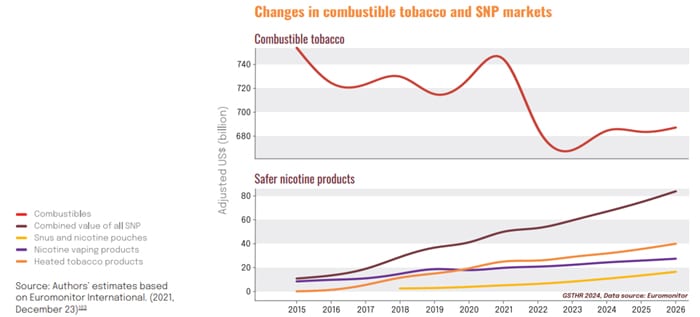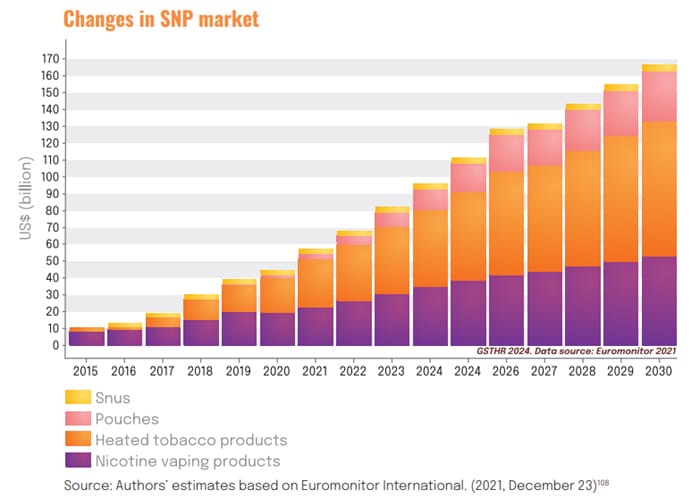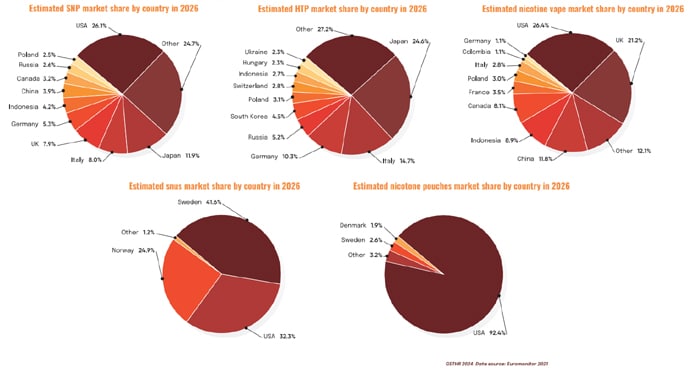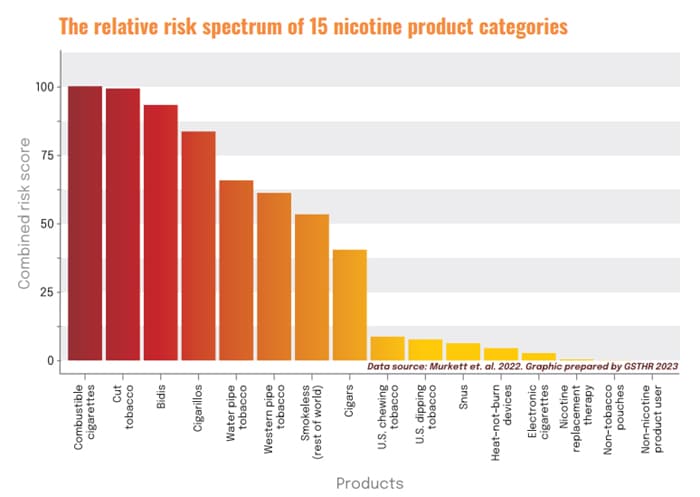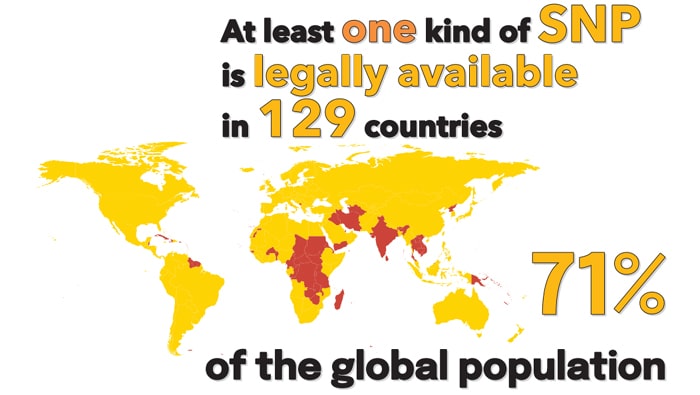Press release
November 2024
Major new report shows global transition from smoking to safer products is underway – authors call for regulation, not prohibition, to drive down tobacco-related deaths
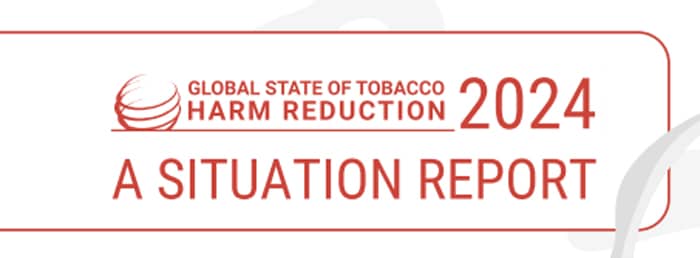
- Safer nicotine products (SNP) are increasingly substituting for cigarettes, with inflation-adjusted combustible tobacco sales in decline and SNP sales increasing six-fold since 2015;
- Analysis shows strong evidence of association between the rise in SNP use and a corresponding decrease in smoking in many countries, at rates far exceeding those achieved by tobacco control measures alone; market data from many countries adds further evidence for substitution;
- Report reveals that more than two-thirds of the world’s population – in nearly 130 countries – can currently access at least one form of SNP legally – while 100% can still buy cigarettes;
- Governments must recognise and seize the opportunity SNP offer to drive down smoking rates, with risk-proportionate regulations to enable people to quit smoking and switch.
Today sees the launch of The Global State of Tobacco Harm Reduction 2024: A Situation Report (GSTHR 2024). The publication is the fourth in a landmark series from UK-based public health agency Knowledge∙Action∙Change (K∙A∙C), which, since 2018, has demonstrated how tobacco harm reduction (THR) using safer nicotine products (SNP) can mitigate the devastating impact of smoking-related diseases that continue to cause eight million deaths every year.
The extent to which SNP are replacing and substituting for combustible and risky oral tobacco products is the report’s central theme. Co-authored by experts in harm reduction, data science and economics, GSTHR 2024 considers what is driving these changes, how different regulatory environments have developed, and the complex interplay between products, consumers, and policy and regulation.
The opening section, ‘A Global Perspective’, uses the latest evidence and new data projections to assess the current global THR situation and its potential to rapidly reduce tobacco-related disease and mortality. The latest market data shows that while sales of combustible tobacco remain significantly higher than sales of SNP, two key shifts are occurring in the tobacco and nicotine market: firstly, the total market share of SNP is increasing, and secondly, inflation-adjusted combustible tobacco sales are declining, while SNP sales are experiencing rapid growth.
Although the nominal value of combustible tobacco sales increased from $752 billion in 2015 to over $1 trillion in 2024, when adjusted for inflation (and assuming a constant currency value), combustible tobacco sales actually decreased to $685 billion in 2024 – an 8.9% decline. Meanwhile, inflation-adjusted SNP sales grew nearly sixfold from 2015, reaching, in non-adjusted terms, $96 billion in 2024.
Further analysis shows, however, that Chinese data skews these figures. China’s tobacco market accounts for an astonishing $344 billion of the $1 trillion global combustible tobacco market. Despite being the global centre of production for nicotine vapes, the Chinese market for all SNP is extremely small, at less than 1.2% of its market for combustibles. GSTHR analysis removing China from the calculations reveals the true scale of the acceleration in the global SNP market: it has reached 12.3% of the total tobacco and nicotine market in 2024, up from virtually zero in 2004.
Adding weight to the substitution argument, analysis of prevalence data shows there is strong evidence of an association between the rise in SNP use and a corresponding decrease in smoking prevalence in the following countries: Sweden, Norway, New Zealand, the UK, the US, Ireland, Luxembourg and the Philippines, and to a lesser extent, Austria and Lithuania. The rates of reduction in many countries far exceeds those achieved by tobacco control measures alone. Market data also show that as the popularity of heated tobacco products (HTP) accelerates in numerous markets, there is a coincidental decline in cigarette sales, again suggestive of a substitution effect. In Kazakhstan, Lithuania and Portugal, cigarette sales have been dropping but more slowly than HTP sales have increased. However, in Hungary, South Korea, Italy and Germany, there has been approximately a one-to-one substitution of HTP sticks for cigarettes, and in Slovakia, Czechia, Russia, Japan and Greece, cigarette sales have dropped faster than HTP sales have increased.
Legal access to a range of SNP will be essential for the billion people who smoke worldwide to benefit from THR. Research undertaken for GSTHR 2024 shows that more than two-thirds of the world’s adult population – in nearly 130 countries – can now legally access at least one form of SNP. Access to combustible tobacco products, known to kill up to half of all users, remains legal for 100% of the world’s adult population. The report also reveals, in an update to previous GSTHR research, that the global number of vapers has increased from 58 million in 2018, to reach an estimated 114 million in 2023. With 30 million people using other safer nicotine products, this means the GSTHR estimates there are now around 144 million users of SNP worldwide.
The second section of GSTHR 2024, ‘Regional and National Insights’, goes into more depth to explore how different countries and regions have responded to THR. THR and tobacco use in both Latin America and Eastern Europe and Central Asia are explored. While consumers can purchase SNP in most countries in Latin America, this is often from unregulated and potentially risky sources. Whereas in Eastern Europe and Central Asia, the relatively late implementation of tobacco control measures in the post-Soviet era means there are high rates of smoking, and risky oral product use persists across the region. SNP uptake is comparatively low, and recognition of THR virtually non-existent.
Four countries that have enabled THR to drive down smoking rates – the UK, Japan, Norway and Aotearoa New Zealand – are profiled. Showing different paths to achieving reductions in smoking prevalence, these short studies demonstrate that minimal financial investment from the state has been required. In Japan, a non-interventionist tobacco policy allowed for the advertising of HTP as safer than smoking, and consumers responded. In Norway, improvements to the manufacturing process of snus made it safer, and those who smoked switched back to a safer product that had fallen out of favour despite its 200-plus year history in the country. The UK’s generally supportive, public health-oriented policies developed after a long history of harm reduction in drugs and HIV/AIDS prevention; the government of Aotearoa New Zealand similarly supported people to switch from cigarettes to vapes, contributing to a significant reduction in smoking prevalence.
The World Health Organization continues to deny any potential health benefits of switching from cigarettes to SNP. The organisation and its allies have sought to encourage countries to introduce regulatory frameworks at least as restrictive as those for cigarettes, and in some cases more so. In several countries, the result is that safer products have been banned while cigarettes remain universally available. But there are signs of hope. At the 2024 Conference of the Parties (COP) to the Framework Convention on Tobacco Control in Panama, some Parties signalled that they are uncomfortable with the current position on tobacco harm reduction. The next COP meeting a year from now, in November 2025, will be one to watch.
GSTHR 2024 shows the consumer base is growing, alongside evidence of the public health benefits of the substitution of SNP for smoking. If fully realised, tobacco harm reduction has the potential to rapidly reduce the global number of smokers. This would deliver one of the greatest public health gains of the 21st century.
Harry Shapiro, Executive Editor and Lead Author of The Global State of Tobacco Harm Reduction 2024: A Situation Report said:
“People talk about a war on smoking, a war on nicotine or a war on vapes. But you don’t conduct a war against inanimate objects. This is a war against people. Those against tobacco harm reduction don’t want people to use safer nicotine products. They’re putting everything in their path to stop them, to the detriment of public health. And keeping people smoking just keeps more profits flowing to the tobacco industry.
“Despite the many barriers, we estimate that 140 million people around the world are using safer nicotine products. Many countries are showing significant reductions in smoking or falls in cigarette sales as SNP use increases, far faster than tobacco control has achieved alone. Safer nicotine products are here to stay. Let’s hope they are allowed to stub out the cigarette for good.”
Professor Gerry Stimson, co-founder of K∙A∙C which runs the GSTHR project, said:
“The safer nicotine products available in 2024 offer what could be considered a classic harm reduction opportunity. The cigarette is a dirty delivery system, but it became the dominant route of nicotine administration, with the attendant risks of combustion and smoke inhalation leading to disease, disability and millions of deaths every year. But people can now consume nicotine without burning tobacco, by switching to significantly safer alternatives like vapes, heated tobacco products, snus and nicotine pouches.
“Harm reduction is often thought about as policies and strategies, driven by public health. But it isn’t only this. It’s also what people do themselves to reduce risks and improve their own health. Governments and both international and national health organisations, need to help create an environment in which people can be informed and empowered to make those safer choices. And the evidence from this report shows that – when safer products are appropriate, acceptable, accessible and affordable – people will switch, in fact are already switching, in their millions.”
Giorgi Mzhavanadze, GSTHR Economist, said:
“Growing evidence suggests that SNPs hold significant potential in reducing smoking prevalence, smoking-related mortality, and life-years lost from smoking. There seems little doubt that they are already making a positive impact on public health. However, fully realising the potential offered by these products as substitutes for cigarettes depends on the pace and scale of the transition. This will largely be dictated by national regulations and control measures, which, unfortunately, so often hinder rather than support these goals.”
Tomasz Jerzyński, GSTHR Data Scientist, said:
“Monitoring smoking and SNP use is important; it allows us to understand the extent to which safer alternatives are replacing combustible tobacco. To observe and quantify this process, the dynamics of smoking and SNP use must be monitored over time. At the moment, data has to be drawn from multiple sources. These include official prevalence estimates, national or smaller scale population surveys and, where available, market data. The resulting figures are comparable only with the application of numerous assumptions, and cannot be taken as evidence, only insights. We hope more countries will adopt better monitoring practices over time.”
ENDS
Notes to editors
About us: Knowledge·Action·Change (K·A·C) promotes harm reduction as a key public health strategy grounded in human rights. The team has decades of experience of harm reduction work in drug use, HIV, smoking, sexual health, and prisons. K·A·C runs the Global State of Tobacco Harm Reduction (GSTHR) which maps the development of tobacco harm reduction and the use, availability and regulatory responses to safer nicotine products, as well as smoking prevalence and related mortality, in over 200 countries and regions around the world. For all publications and live data, visit https://gsthr.org.
Our funding: The GSTHR project is produced with the help of a grant from Global Action to End Smoking (formerly known as Foundation for a Smoke-Free World), an independent, US nonprofit 501(c)(3) grant-making organisation, accelerating science-based efforts worldwide to end the smoking epidemic. The project and its outputs are, under the terms of the grant agreement, editorially independent of the Foundation. Global Action played no role in designing, implementing, data analysis, or interpretation of this Briefing Paper. The contents, selection, and presentation of facts, as well as any opinions expressed, are the sole responsibility of the authors and should not be regarded as reflecting the positions of Global Action to End Smoking.
The report: The Global State of Tobacco Harm Reduction 2024: A Situation Report is a multi-component publication, grouped into two parts, ‘A Global Perspective’ and ‘Regional and National Insights’. ‘A Global Perspective’ uses the latest evidence and new data projections to report on the current global tobacco harm reduction situation and its potential to rapidly reduce the burden of disease and mortality associated with risky tobacco use, over six chapters. ‘Regional and National Insights’ takes an in-depth look at the status of tobacco use and THR in two regions, Latin America, and Eastern Europe and Central Asia. It also includes up-to-date assessments of four countries that, in different ways, have enabled THR to drive down smoking rates: the United Kingdom, Japan, Norway and Aotearoa New Zealand.
To access the full report, visit: https://gsthr.org/resources/thr-reports/the-global-state-of-tobacco-harm-reduction-2024-a-situation-report/.
